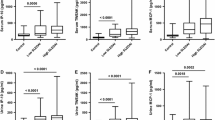Summary
To explore the expression and clinical significance of molecular chaperone heat shock protein 90 (HSP90) in peripheral blood mononuclear cells (PBMC) and plasma level of interleukin-6 (IL-6) in patients with systemic lupus erythematosus (SLE), HSP90 was detected in PBMC by Western blot assay and the plasma level of IL-6 was measured by ELISA in 38 SLE patients and 20 normal controls. The correlation analysis was performed between the SLE disease activity index (SLE-DAI) and the expression of HSP90 and IL-6. The results showed that there was increased expression of HSP90 in the SLE patients. The active SLE group exhibited higher HSP90 levels (0.82±0.10) than the inactive SLE group (0.54±0.09) (P<0.01). The expression of HSP90 in normal control group (0.37±0.11) showed significant statistical difference as compared to both the inactive and active SLE groups (P<0.01, P<0.01, respectively). The plasma level of IL-6 exhibited a significant increase in both the inactive and active SLE groups (28.99±1.74 pg/mL 44.58±9.15 pg/mL, respectively) compared with normal control group (P<0.01, P<0.01, respectively). The expression of HSP90 and IL-6 in SLE patients showed significant positive correlation with SLEDAI scoring (r=0.80, P<0.01; r=0.74, P<0.01, respectively). In addition, there was a positive correlation between the level of IL-6 and HSP90 in SLE patients (r= 0.86, P<0.01). The increased expression of molecular chaperone HSP90 and IL-6 may play an important role in the pathogenesis of SLE by regulating autoimmunity.
Similar content being viewed by others
References
Zhang J, Tian B. HSPs and their biological function. Overseas Medicine (Surgery) (Chinese), 2003,30(5):265–268
Stephanou A, Amin V, Isenberg D A et al. Interleukin 6 activates heat-shock protein 90 beta gene expression. Biochem J, 1997,321(Pt1):103–106
Shen G X. Separation and purification of peripheral blood mononuclear cells. Modern experimental technology of immunology, 2th ed. Wuhan: Hubei Science and Technology Publishing Company, 1998,377–390
Faulds G, Conroy S, Madaio M et al. Increased levels of antibodies to heat shock proteins with increasing age in Mrl/Mp-lpr/lpr mice. Br J Rheumatol, 1995,34(7):610–615
Li J H, Han S X, Gao K B et al. Study of HSP90 and its subgroup mRNA in lupus nephritis patient. Chin J Kassa Dermatol (Chinese), 2005,21(1):1–3
Kenderov A, Minkova V, Mihailova D et al. Lupus-specific kidney deposits of HSP90 are associated with altered IgG idiotypic interactions of anti-HSP90 autoantibodies. Clin Exp Immunol, 2002,129(1):169–176
Zeng L X, Ye R G, Sun L et al. The observation of over expression of IL-6 in PBMC in vivo of the lupus nephritis patients. Chin J Microbiol Immunol (Chinese), 1997,17(6):442–445
Yang G Y, Liu H T, Li S M et al. The impact of IL-6 gene dosaging on pathogenesis of BXSB lupus mice. Chin J Dermatol (Chinese), 1999,32(1):22–24
Stephanou A, Conroy S, Isenberg D A et al. Elevation of IL-6 in transgenic mice results in increased levels of the 90 kDa heat shock protein (HSP90) and the production of anti-HSP90 antibodies. J Autoimmun, 1998,11(3):249–253
Pramanik R, Jorgensen T N, Xin H et al. Interleukin-6 induces expression of Ifi202, an interferon-inducible candidate gene for lupus susceptibility. J Biol Chem, 2004,279(16):16121–16127
Stephanou A, Isenberg D A, Akira S et al. The NF-IL6 and STAT-3 signalling pathways co-operate to mediate the activation of the HSP90βgene by IL-6 but have opposite effects on its inducibility by heat shock.. Biochem J, 1998,330(Pt1):189–195
Author information
Authors and Affiliations
Rights and permissions
About this article
Cite this article
Hu, S., Xu, Q., Xiao, W. et al. The expression of molecular chaperone HSP90 and IL-6 in patients with systemic lupus erythematosus. J. Huazhong Univ. Sc. Technol. 26, 664–666 (2006). https://doi.org/10.1007/s11596-006-0609-1
Received:
Issue Date:
DOI: https://doi.org/10.1007/s11596-006-0609-1



